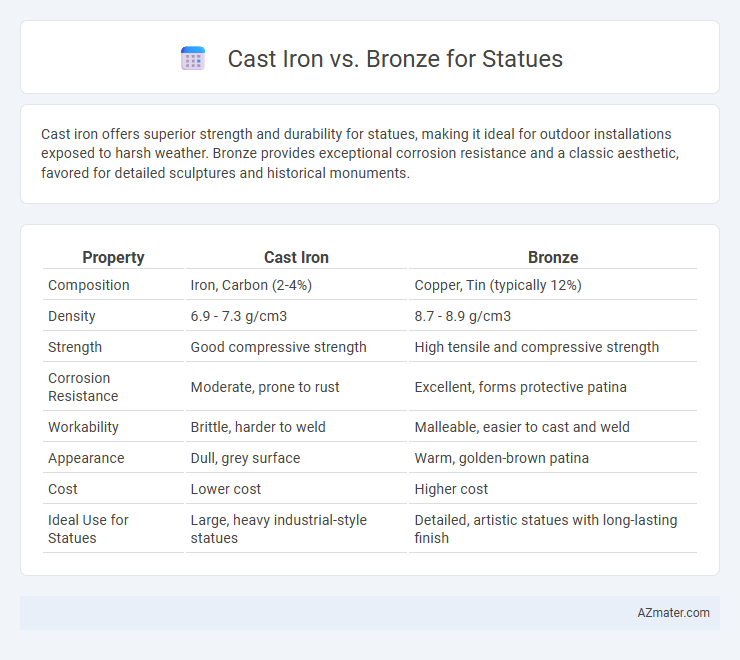Cast iron offers superior strength and durability for statues, making it ideal for outdoor installations exposed to harsh weather. Bronze provides exceptional corrosion resistance and a classic aesthetic, favored for detailed sculptures and historical monuments.
Table of Comparison
| Property | Cast Iron | Bronze |
|---|---|---|
| Composition | Iron, Carbon (2-4%) | Copper, Tin (typically 12%) |
| Density | 6.9 - 7.3 g/cm3 | 8.7 - 8.9 g/cm3 |
| Strength | Good compressive strength | High tensile and compressive strength |
| Corrosion Resistance | Moderate, prone to rust | Excellent, forms protective patina |
| Workability | Brittle, harder to weld | Malleable, easier to cast and weld |
| Appearance | Dull, grey surface | Warm, golden-brown patina |
| Cost | Lower cost | Higher cost |
| Ideal Use for Statues | Large, heavy industrial-style statues | Detailed, artistic statues with long-lasting finish |
Introduction to Cast Iron and Bronze Statues
Cast iron statues are known for their durability, resistance to corrosion, and affordability, making them popular for outdoor installations and large sculptures. Bronze statues offer superior detail and a rich aesthetic through their smooth surface, classic patina, and higher tensile strength, ideal for fine art and historic monuments. Both materials have distinct thermal properties and casting techniques that influence their suitability and appearance in statue manufacturing.
Historical Uses of Cast Iron and Bronze in Sculpture
Cast iron and bronze have played significant roles in the history of sculpture, with bronze favored since ancient times for its durability and ability to capture fine details in statues such as those from Greek and Roman civilizations. Cast iron gained prominence during the Industrial Revolution, offering a more affordable and robust alternative for large-scale public monuments and architectural sculptures, exemplified by structures like the Iron Bridge in England. Bronze remains the preferred material for intricate sculptures due to its superior casting properties and resistance to corrosion compared to cast iron.
Material Properties: Cast Iron vs Bronze
Cast iron exhibits high compressive strength and excellent durability but is brittle and prone to cracking under tension, making it less ideal for intricate statue details. Bronze offers superior tensile strength, corrosion resistance, and a smoother surface finish, allowing for fine detail and longevity in outdoor sculptures. The choice between cast iron and bronze for statues depends largely on the desired balance of strength, detail precision, and weather resistance.
Durability and Longevity Comparison
Cast iron statues offer high durability due to their hardness and resistance to wear, but they are prone to rust and corrosion if not properly coated or maintained. Bronze statues, composed primarily of copper and tin, boast superior longevity as they naturally develop a stable patina that protects against environmental damage and oxidation. This makes bronze the preferred material for outdoor sculptures requiring enduring resilience and minimal maintenance over centuries.
Aesthetic Differences in Finished Statues
Cast iron statues exhibit a rugged, industrial aesthetic with a dark, matte finish that emphasizes texture and form, often developing a natural rust patina over time. Bronze statues are renowned for their warm, rich tones and smooth surface, allowing for intricate detailing and a classic, timeless look that deepens to a verdigris green patina with age. The choice between cast iron and bronze significantly influences the visual appeal and historic character of a statue's finished appearance.
Cost Analysis: Cast Iron vs Bronze
Cast iron statues typically cost significantly less than bronze statues due to the lower price of raw materials and simpler manufacturing processes. Bronze, an alloy of copper and tin, commands higher costs not only from expensive metals but also from labor-intensive casting techniques like lost-wax casting. For large-scale sculptures, cast iron offers a budget-friendly alternative with decent durability, while bronze remains a premium choice for fine detail and longevity despite its higher initial investment.
Maintenance and Preservation Requirements
Cast iron statues require regular maintenance to prevent rust and corrosion, often necessitating protective coatings and periodic repainting due to their sensitivity to moisture and environmental exposure. Bronze statues benefit from a natural patina that acts as a protective layer, reducing the frequency of preservation efforts; however, they still require occasional cleaning and waxing to maintain surface integrity and prevent oxidation. Preservation of bronze is generally less intensive compared to cast iron, making bronze a preferred choice for long-term outdoor sculptures with lower maintenance demands.
Environmental Impact and Sustainability
Cast iron production emits higher levels of carbon dioxide due to its energy-intensive smelting process, contributing to greater environmental impact compared to bronze, which typically contains copper and tin sourced with lower carbon footprints. Bronze offers enhanced durability and resistance to corrosion, extending the lifespan of statues and reducing the frequency of replacements, thereby supporting sustainable use of materials. Recycling rates for bronze are generally higher than for cast iron, making bronze a more sustainable choice for long-term applications in monumental sculpture.
Suitable Applications for Each Material
Cast iron is ideal for outdoor statues and large sculptures due to its durability, resistance to weathering, and cost-effectiveness, making it suitable for public monuments and architectural elements. Bronze, known for its superior corrosion resistance, fine detail capture, and classic aesthetic, is preferred for prestigious commemorative statues, intricate art pieces, and historical replicas. Both materials offer longevity, but bronze's patina development and malleability make it better suited for artistic works requiring detailed craftsmanship and refined finishes.
Choosing the Best Material for Your Statue Project
Cast iron offers exceptional durability and cost-effectiveness for statues, making it ideal for large outdoor installations exposed to harsh weather conditions. Bronze provides superior corrosion resistance and intricate detail reproduction, often preferred for fine art sculptures requiring longevity and a classic aesthetic. Evaluating factors such as environmental exposure, budget, and desired finish ensures the best material choice for your statue project.

Infographic: Cast iron vs Bronze for Statue
 azmater.com
azmater.com